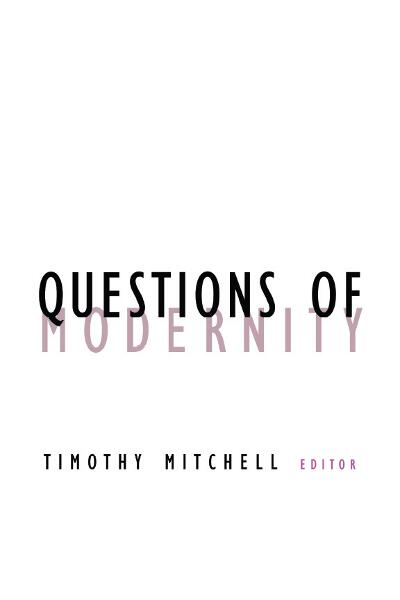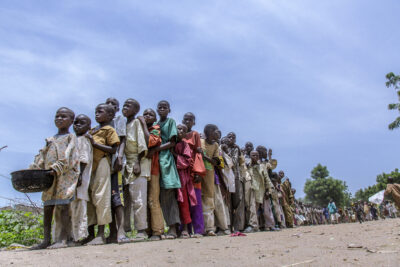In May 1993 a group of scholars of the Middle East and South Asia met in Cairo for a conference on “Questions of Modernity: Strategies for Post-Orientalist Scholarship on South Asia and the Middle East.” The meeting brought together specialists on two regions that the borders of area studies usually keep apart, to explore questions common to the two areas arising out of current critiques of the scholarship of Orientalism and the discourses of modernity.
South Asia and the Middle East are regions that exemplify some of the most pressing and paradoxical features of contemporary global society: the tension between supposedly secular regimes and the religious basis of political allegiances; between the apparent stability of postcolonial national boundaries and the fragility of communal harmony; between ostensibly democratic forms and the realities of oligarchic rule; between the technology of armament and space industries and the poverty of peasant agriculture; between the professional advancement of women and their taking on the veil; between the flow of tourists and the displacement of refugees; between the importing of consumer luxuries and the export of labor migrants; and between the flourishing of film, television, and video industries and the persistence of mass illiteracy.
Such contradictions have commonly been explained in terms of the contrast between tradition and modernity, the two conditions coexisting temporarily as the former gave way to the latter. Yet recent scholarship has shown not simply that the traditional has refused to give way, but that practices that were called traditional are often better understood as the product of recent historical conditions. The traditional and the modern are two outcomes of the same process. Modernity, moreover, is now exposed to all kinds of postmodern crisis and critique. Individualism, secularism, science, culture, and nationhood are no longer the certainties they once seemed. They can be diagnosed as political constructions that have produced particular historical forms of power, self-identity, exclusion, and subjection.
This awareness has demanded the development of new theoretical strategies in history and the social sciences. Once the premodern and the modern are no longer taken as givens, with history as a unilinear movement of development from one to the other and politics as the simple resolving of contradictions between the two, we can analyze modernity not as a historical condition but as a political project. This project can be seen as a process of constructing, grouping, and devaluing certain identities and activities as traditional by placing them in subordinate opposition to another group constructed and privileged as the modern.
Examining the traditional/modern construction
The aim of the Cairo conference was to examine how this traditional/modern construction was created within South Asian and Middle Eastern societies how it is sustained or challenged today, and what forms of subjectivity and social identity are its result. By comparing South Asian and Middle Eastern cases we hoped to focus and deepen these questions, in the belief that, while regional expertise is necessary, many of the assumptions about modernity that govern research on particular regions of the world are sustained by the barrier that area studies maintain between them.
Fifteen participants prepared papers for the conference. We grouped their presentations around three themes: knowledge, nationhood, and subalterns. The first group of papers examined the constitution of scientific and social-scientific knowledge in the colonial and postcolonial state, exploring cases that included biomedicine, development discourse, economics, and political science. The second set of papers dealt with issues concerning the construction of nationhood. The papers drew on sources including literature, cinema, television programming, and the minutiae of cultural style to examine problems of gender identity, domesticity, secularism, and citizenship in the creation of modern political identities. The final group of papers examined the formation of subaltern groups in the colonial period, raising questions about class formation and examining forms of identity and exclusion created by the reordering and representation of rural and national space.
The first theme to emerge from the conference was the need to reexamine the ways in which modernist projects were produced within the colonial context. There was general agreement that this reexamination had progressed further in South Asian than in Middle Eastern studies. For example, the story of how modern biomedical practice was articulated within nineteenth-century Egypt is still structured by a nationalist and modernizing narrative, in which Egyptian reformers employ European experts to struggle against a resistant and ignorant tradition.
“… to reexamine the ways in which modernist projects were produced within the colonial context.”Reexamining the sources, it was argued, revealed a less clear-cut picture. Several elements said to be distinctive of modern biomedicine could be found in premodern Islamic medical practice, while the practice of modern medicine in Egypt was continually transformed or corrupted by local resistance and the unauthorized intermixing of supposedly premodern elements. Similar arguments were made concerning other modernist projects of the colonial and postcolonial period.
Displacing modernity
Participants in the meeting raised several problems with this effort to reconceptualize the nature of modernity in the colonial encounter. Some participants questioned the weight being given to the colonial dimension of the encounter, as well as the broader revival of interest in colonial studies. They pointed out that in the Middle East several countries, including Turkey and Iran were never formally colonized, yet developed similar modernist projects and encountered similar forms of resistance and transformation.
Other participants argued that this kind of revision of the account of modernist projects failed, more fundamentally, to break with the general narrative of modernity and tradition. By bringing to light the presence of modernist elements in the premodern or the corruption of modernity by the traditional elements it claimed to replace, one could complicate the story of modernity but not escape its basic terms. The critique remained within a narrative of the coming of modernity from the West and local attempts to resist or alter it. It did not disturb or displace the positions the different elements occupy in this story, positions which are themselves assigned by the larger project of modernity.
Our discussion of the various papers brought out a number of different ways to try and move beyond these positions. One set of debates turned around the place of religious-based and minority politics in the modern state. In the development of Indian nationalism, for example, a thoroughly secular and scientific approach to the reorganization of society was continually corrupted by an appeal to religion as the source of national strength and identity. This inconsistency, it was argued, did not represent the persistence of traditional elements or their influence over individual modernist thinkers, but an ambiguity in modernist discourse itself. The attempt to organize society scientifically was popularly perceived as elitist and Western, and associated with the colonial power. However, this negative perception was reduced by the contradictory appeal to religion. Modernity’s need to appropriate religion for the nationalist project can be seen as a mark of its failed hegemony. But the contradiction opened up a space for the organization of religion as political interest within the frame of nationalist politics—and hence for the modern and wholly secular politics of communalism.
The constitution of a national minority within the modern state provided a further avenue to explore the ambiguities of modernist discourse. Nationalism claims to be a universal and unifying discourse, but its universalism tends to emerge from the contingent, provisional articulation of disparate elements and is inevitably incomplete. Thus Indian nationalism brought together the radical, scientific-based secularism of Nehru with the populist, Gandhian appeal to a subaltern culture dense with Hindu religious symbolism. This combination inevitably placed Muslim Indians in the ambiguous position of a national minority, unable to be considered modern Indians unless they abandoned their Muslim identity and unable to be Muslim unless they abandoned their claim to equal citizenship. Muslim separatism, it followed, was not the expression of a primordial identity but the necessary Muslim response to a modernity that offered them only the partial identity of being the minor term, the other, of Indian nationalism.
From the issues of national minorities we moved to a broader set of questions about the construction of modern identities. In the critique of modernity, it was argued, we need to reexamine the way the histories of local subjectivities always tend to be written from the perspective of a global narrative of transformation. The story of working-class formation, for example, is never a uniform process and cannot be reduced to the mechanical emergence of a social group to self-consciousness. In the Egyptian case it was shown how working-class identity was created discursively in the context of a dominant discourse of nationhood and citizenship. The terms and positions in this discursive field came to be perceived as fixed and essential identities, but were in fact the contingent outcome of unequal local struggles.
Somewhat similar processes were discussed in the constitution of the Sa‘idi, the person from southern Egypt, as the outsider within Egyptian national identity. Since the nineteenth century, it was argued, the multiple cultural forms, different identities, and varieties of domination among the peoples of the Egyptian south have taken on an abstract singularity. The Sa‘idi has come to represent tradition. He is defined in terms of an ahistorical and antimodern essence, always outside the story of Egyptian nationalism, an abnormality in need of emancipation.
How this fixing occurred can be traced in particular through the social production of the Sa‘id as a fixed space—in cadastral surveys, irrigation projects, and development schemes since the nineteenth century that homogenized and located Sa‘idi with a geographical space imagined in terms of an emergent agro-economic discourse, that is, in terms of their encounter with the metropolitan projects of modernity. The power of this fixing can be seen in the way Sa‘idis continued to occupy this original space of tradition, even as the uneven development of capitalism forced their migration north and abroad.
The modernist construction of space and personhood was also explored in the case of the making of a coolie in colonial Ceylon. Modernity brought unique notions of boundary, shaping simultaneously the construction of territorial space and of personhood. The plantation in Ceylon was imagined as a bounded, controlled space, like a state, but it boundaries were actually porous and the separation between it and the local village was imperfect at best. The coolie, on the other hand, was denied personhood: he/she was not a properly bounded modern self since, as an unskilled worker, he/she was robbed of agency. Both the plantation and the coolie fell short of the modernist image of the genuinely modern and in this sense gave justification to colonial control.
Hybrid categories
Another way in which questions of spatial imagery and the boundary were used to interrogate modernist discourse was in the discussion of the idea of an economy. The discursive construction of the modern economy as a uniform space presumes a noneconomic exterior. The household, particularly the subsistence-oriented rural household, is imagined to occupy such an external space, outside the capitalist economy. Yet studies of individual households reveal people living hybrid lives that cannot be resolved into the economic versus the noneconomic or capitalism versus subsistence. If rural households escape the categories of modernist discourse, it was argued, the point is not to celebrate this as a form of resistance, seeing in the peasantry a primordial opposition to modernity, but to show how modernism’s categories are necessarily incomplete and cannot mark their own edges. The attempt to establish an edge creates a margin of indeterminacy that modernity cannot erase.
“Modernity can only produce itself out of the process of differentiating what is non-modern.”This topic was one of several in which our discussion focused on the indeterminacy produced at the point of contact between the modern and the non-modern. These moments of indeterminacy were explored most fully in an analysis of the articulation of modern science in colonial India. To produce the authority of science, it was shown, scientific discourse had to engage continuously with local forms of knowledge and belief, which were to be repositioned as archaic and irrational. Modernity can only produce itself out of the process of differentiating what is non-modern. But this process is always one of renegotiation and translation, in which neither side remains the same. For in appropriating the non-modern to perform its authority, the modern is always open to contagion, to dissemination, to hybridization. Its singular authority and authenticity, it was argued, is always produced out of this hybridity.This discussion brought us back to the central question of whether one can write analyses of modernity that disturb, rather than reproduce, the positions and oppositions mapped out by the discourses of modernity itself. At least three points emerged. First, focusing on the performance or articulation of modernity enables us to break with the historical narrative that always locates the origin of modernity in the West and represents the non-West only in terms of its efforts to copy and/or resist an imported, second-hand modernity. To produce the modern always already requires the non-modern, the space of colonial difference. Second, concentrating on the local articulations and dissemination of modernity means paying less attention to the grand designs of the colonial or modernizing state and more attention to the myriad local sites where the modern is produced, and transformed, in its encounter with, and production of, the non-modern. Third, the categories and oppositions that are renegotiated in these sites produce particular, contingent transformations. Such local dislocation can represent points of weakness, where the strategies of modernity are renegotiated, its binary oppositions displaced, and its apparently fixed and overarching identities disturbed.
Certain images from the case studies condensed some of these issues in such a vivid way that they came to be invoked in our discussion as metonyms. For example, the recollections of an elite child’s perception of lower class picnickers on a Turkish island as inappropriately dressed interlopers became “men in their pajamas.” The reference was to the way a powerful modern/traditional distinction came to be mapped onto class and status differences marked by dress and everyday behavior. The day-trippers wearing pajamas and recreating domestic scenes outdoors were perceived as traditional when in fact the practice of picnicking and the form of urban leisure it represented were entirely novel. A second example was an image from Satyajit Ray’s film, The Home and the World, in which the protected mistress of the Indian home fingered the sumptuous fabric of her English-manufactured saris. The home, the scene of the traditional, is shown here as always already infiltrated by it supposed opposite, the world of colonial power, even as the two are counterposed.
Choosing tools and strategies
“The challenge is how to allow for a third possibility besides resistance or capitulation to modernist projects on the part of those subjected to them.”In shifting our attention to the particular sites at which modernity and its opposite are articulated or staged, we were challenged by the need to develop appropriate conceptual tools. The effort to grasp the complex nature of everyday realities of subaltern groups like rural television viewers in Egypt, the target of the didactic modernizing efforts of urban culture industry professionals, led to a series of debates about the relative analytical power and theoretical implications of terms such as compartmentalization, leakage, dissemination, seepage, hybridity, and the Gramscian “common sense.” It was suggested that the condition of modernity itself was one in which the eclectic cultural experiences of such social groups might seemingly be bifurcated into traditional and modern elements only because of their anxiety about the future and the analysts’ anxiety about hybrid categories. The challenge is how to allow for a third possibility besides resistance or capitulation to modernist projects on the part of those subjected to them, an intellectual project made necessary by the obvious fact that global homogenization has not occurred.
This particularization of what in the modernist project is presented as universal and abstract was vividly exemplified in the literature of nineteenth- and early twentieth-century Iran on the homeland. Nationhood is a key term in the lexicon of modernity. Yet in this case, the gendering of the concept of the nation in literature, presenting it variously as a mother figure and a lover, enabled a stunning range of nationalist sentiment from protectiveness to erotic love. In turn, this visioning of the nation as female had implications for the rights of women a citizens and compatriots. This case, like many analyzed by feminist scholars, shows how specific and various are the supposed universalisms of modernity.
At various points during the conference, animated debate provoked by concerns about the political implications of critiques of modernity and arising from experiences in specific Middle Eastern or South Asian countries reminded us of the contradictions of modernist projects. Perceived as emancipatory by certain social groups such projects as literacy, biomedicine, and republicanism opened up spaces for new activities and new subjectivities that transformed the social map and people’s lives. Similarly, it was argued, critiques of modernity might also be politically enabling, especially in the refiguring of possibilities for identity in situations constrained by the terms of modernist discourse, such a communalist India.
It had been our intention, in organizing this conference, to address certain contradictions inherent in the theoretical ground opened up by the critique of Orientalism. We had noted that there was a tension between relying on the post-structuralist critique of Enlightenment values and invoking some of those same emancipatory and humanist values in order to engage with authoritarian political and cultural structures. Such contradictions could be related to broader contradictions within South Asian and Middle Eastern societies, where political groups find themselves challenging the West or its modernity in the name of an authenticity and selfhood that has itself been formed within the history of the modernizing project and therefore tends to incorporate aspects of the Orientalist tradition. Our intention was not to move beyond these contradictions, which are probably inevitable, but to help bring them to light and show how an awareness of them could deepen our understanding of the distinctive history and politics of modernity.
“Modernity must always reach out to appropriate what is alien in order to perform itself.”Our discussion helped clarify the ways in which, within any master narrative or discourse, however encompassing it categories appear, lie elements that allow for both self-critique and the potential for moving beyond it. As one participant put it, recalling the men in pajamas, “Modernity is a discourse in drag; it is always cross-dressed.” In other words, it must always reach out to appropriate what is alien in order to perform itself, to establish its difference. In this attempted appropriation, dislocations occur and points of weakness emerge. It is from these points that a post-Orientalist critique can begin.
This article draws in detail upon the arguments presented in the individual conference papers whose authors and titles are listed here.1 The participant and papers at the Cairo conference were:
→Lila Abu-Lughod, “Not Falcon Crest: Culture as Politic in Egyptian Television”
→Partha Chatterjee, Center for Studies in Social Science, Calcutta, “A Modern Science of Politics For India”
→E. Valentine Daniel, University of Michigan, “The Coolie: A Not-So-Modern-Person in a Hyper-Modern Space?”
→Nicholas Dirks, University of Michigan, “The Home and the World: The Invention of Modernity in Colonial India”
→Khaled Fahmy, Cairo, “Medicine and Power in 19th Century Egypt”
→Deniz Kandiyoti, University of London, SOAS, “Gendering the Modem: Refashioning Masculine and Feminine Identities”
→Zachary Lockman, Harvard University, “Imagining the Working Class: Culture, Nationalism and Class Formation”
→Timothy Mitchell, “At the Edge of the Economy”
→Soheir Morsy, Alexandria, “Socio-medical Discourse and Critical Scholarship: Modernism, Post-Modernism, and the Pursuit of Relevance”
→Aamir Mufti, Columbia University, “Sign of Trouble: The Muslim Problem in Indian Modernity”
→Afsaneh Najmabadi, Barnard College, Columbia University, “Beloved and Mother: The Erotic Vatan: To Love, to Hold and to Protect”
→Pramod Parajuli, Society for Participating Cultural Education, Nepal, “Beyond India the ‘Orient’ and India the ‘Underdeveloped’: Toward a Non-Dominating Knowledge”
→Gyan Prakash, Princeton University, “Authorizing Science as Modernity in Colonial India”
→Martina Rieker, American University in Cairo, “Marginality and Modernity: Figuring the Sa‘idi Peasantry in the Egyptian Nation.”
Michael Gilsenan, Oxford University, prepared a paper, “Histories, Narratives, and Modernities: Problem in Writing Anthropology,” but was unable to attend.
In addition, Soraya Altorki, American University in Cairo; Joel Beinin, Stanford University; Huri Islâmoglu-Inan, Middle East Technical University; Huda Lutfi, American University in Cairo; and Ted Swedenburg, American University in Cairo, served as discussants. Two members of the SSRC staff, Steven Heydemann and Toby Volkman, attended the conference and a third, Ben Zimmer, provided valuable help in it preparation. At the same time, within the limit of this report, we have been unable to represent the argument of every paper or to cover the full range of debate and disagreement that the papers provoked.
Funding for the Question of Modernity project was provided by an SSRC Transnational and Comparative Research Grant with additional support from the Joint Committee on the Near and Middle East. The authors of this article initiated the project, in consultation with Gyan Prakash (Princeton University) and Rosalind O’Hanlon (Cambridge University). A planning meeting in New York in April 1992 also included Shahid Amin, Institute for Advanced Study Berlin/Delhi University; Ayesha Jalal, Columbia University; Zach Lockman, Harvard University; and David Ludden, University of Pennsylvania.
Several of the conference papers subsequently appeared as a book, Questions of Modernity.2 University of Minnesota Press, 2000.
University of Minnesota Press, 2000.
More info →
This essay originally appeared in Items Vol. 47, No. 4 in the winter of 1993. Visit our archives to view the original as it first appeared in the print editions of Items.
References:
→Lila Abu-Lughod, “Not Falcon Crest: Culture as Politic in Egyptian Television”
→Partha Chatterjee, Center for Studies in Social Science, Calcutta, “A Modern Science of Politics For India”
→E. Valentine Daniel, University of Michigan, “The Coolie: A Not-So-Modern-Person in a Hyper-Modern Space?”
→Nicholas Dirks, University of Michigan, “The Home and the World: The Invention of Modernity in Colonial India”
→Khaled Fahmy, Cairo, “Medicine and Power in 19th Century Egypt”
→Deniz Kandiyoti, University of London, SOAS, “Gendering the Modem: Refashioning Masculine and Feminine Identities”
→Zachary Lockman, Harvard University, “Imagining the Working Class: Culture, Nationalism and Class Formation”
→Timothy Mitchell, “At the Edge of the Economy”
→Soheir Morsy, Alexandria, “Socio-medical Discourse and Critical Scholarship: Modernism, Post-Modernism, and the Pursuit of Relevance”
→Aamir Mufti, Columbia University, “Sign of Trouble: The Muslim Problem in Indian Modernity”
→Afsaneh Najmabadi, Barnard College, Columbia University, “Beloved and Mother: The Erotic Vatan: To Love, to Hold and to Protect”
→Pramod Parajuli, Society for Participating Cultural Education, Nepal, “Beyond India the ‘Orient’ and India the ‘Underdeveloped’: Toward a Non-Dominating Knowledge”
→Gyan Prakash, Princeton University, “Authorizing Science as Modernity in Colonial India”
→Martina Rieker, American University in Cairo, “Marginality and Modernity: Figuring the Sa‘idi Peasantry in the Egyptian Nation.”
Michael Gilsenan, Oxford University, prepared a paper, “Histories, Narratives, and Modernities: Problem in Writing Anthropology,” but was unable to attend.
In addition, Soraya Altorki, American University in Cairo; Joel Beinin, Stanford University; Huri Islâmoglu-Inan, Middle East Technical University; Huda Lutfi, American University in Cairo; and Ted Swedenburg, American University in Cairo, served as discussants. Two members of the SSRC staff, Steven Heydemann and Toby Volkman, attended the conference and a third, Ben Zimmer, provided valuable help in it preparation.














